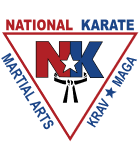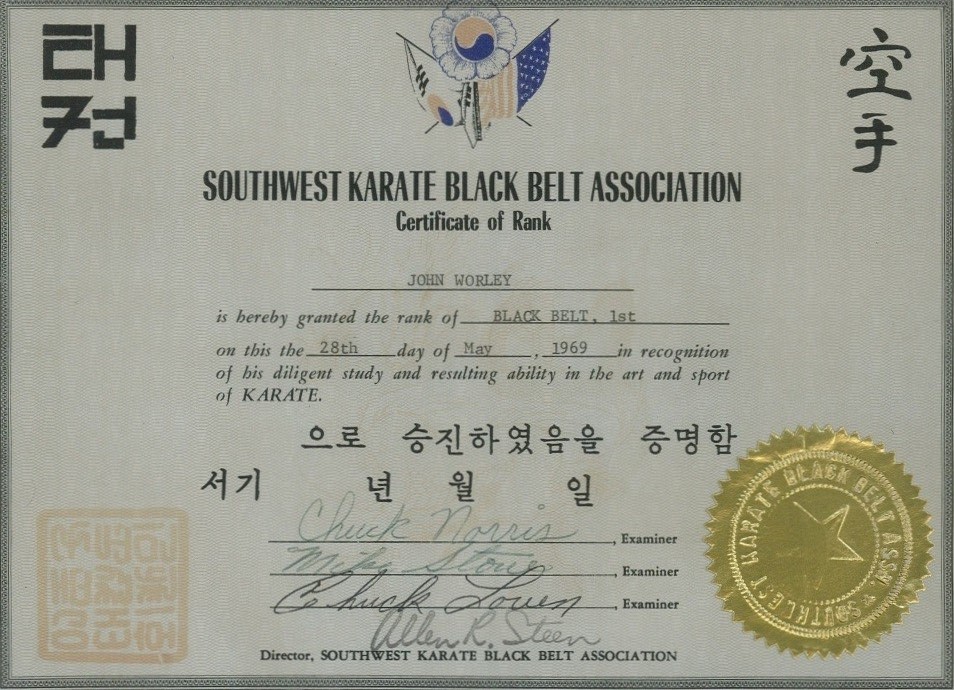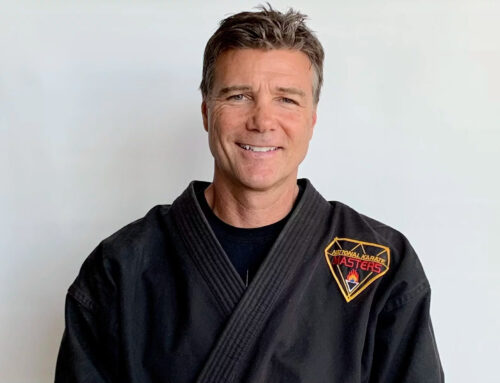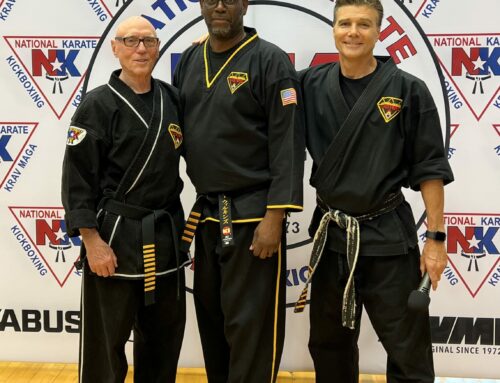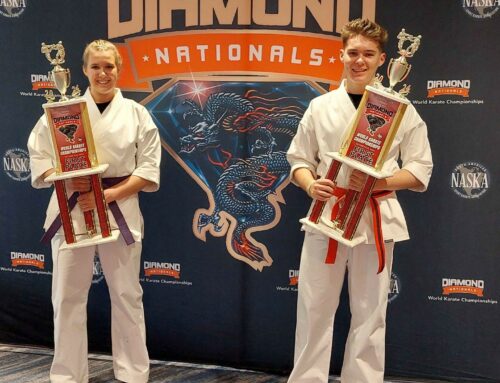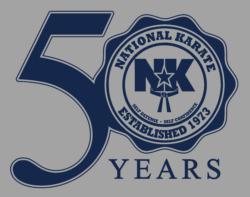
This year marks a very special milestone in martial arts history as National Karate celebrates its 50th Anniversary! I asked my Instructor, Grand Master John Worley, who is the founder of the National Karate schools to share his memories of the past 50 years for our students. Grand Master Worley is one of the true pioneers of martial arts in America and is credited with being part of the popularization and expansion of martial arts in the United States. He was there at the beginning and these are his memories…
(Introduction by Cristian Nelson)
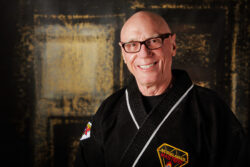
Grand Master Worley – What I’ve Seen
Chapter 1; The Early Days – Texas – 1967 – 1970
My earliest exposure to any sort of Martial Arts came in February of 1967 when my then seventeen-year-old younger brother Pat demonstrated his Taekwondo green belt skills in our Grandparents’ front yard in Hamilton, Texas. Five years his senior, I had always been able to manhandle him as older brothers often do to their younger siblings. That all changed that day as he demonstrated his kicks, punches and even broke a brick from Pat’s flower garden. Patty and I were intrigued with his “exotic” new skills. I immediately wanted to learn more about Taekwondo and Karate.
I was well into my second year of marriage to Patty and we had a 5-month-old daughter, Darbi. After being a high school football player, I had slipped into my early adulthood and early married life as a sedentary guy who had learned to smoke cigarettes and enjoy my wife’s cooking. I was carrying around about 35 un-needed pounds and had no interest in most physical activity. That too, changed that day.
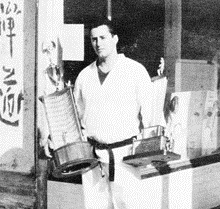
J. Pat Burleson – First American Champion
When we returned to our home in Dallas, Texas, Patty and I visited an Allen Steen Texas Karate Institute. Grand Master (GM) Allen Steen in the Dallas area along with GM J. Pat Burleson in Ft. Worth were two genuine US Martial Arts pioneers and were among the very first people to open commercial Martial Arts schools in America. GM Steen was one of Korean master Jhoon Rhee’s first black belts. Jhoon Rhee is considered the “Father of USA Taekwondo” (much more about him in my next article). We watched some classes and were amazed by the kicking skills, flexibility and control the black belt instructor was demonstrating. But before we decided to enroll there, we wanted to visit the school where my brother was taking his training, the Worth Health Studio in neighboring Ft. Worth. Pat said if we enrolled there, he would get a new uniform and would give it to me. Then we would just have to purchase one for Patty.
The Worth Health Studio was a very small gym with barbells and other basic weight training tools with an even smaller side room allocated for the Taekwondo classes. There was a tiny lobby next to the Karate room and there were swinging doors leading into it. As we waited in the lobby to speak to the instructor, suddenly a brown belt student was forcefully kicked through the swinging doors landing flat on his back and right at our feet. He jumped up, straightened his uniform, issued a deafening yell and charged back through the doors. I looked at my wide-eyed wife and said cool! I was hooked.
Patty and I enrolled that night and started our training on Thursday, March 9, 1967, obviously a day I will never forget. I stopped smoking that same day. Our instructor was a first- degree black belt named Charles (Chuck) Loven. Mr. Loven was originally from Breckenridge, Texas and legend has it that he was forced into the military by the local Breckenridge police captain as an alternative to jail time for beating up some of the local hooligans—deals like that were not uncommon in small town Texas in those days.
After serving his military commitment, Chuck moved to Ft. Worth, found employment and began Karate training under Ft Worth Karate pioneer, J. Pat Burleson who had recently been promoted to first degree when Patty and I started our Martial Arts journey. In 1967, our classes at Worth Health were typically composed of 6 to 8 people of various belt ranks. The classes were almost exclusively adults, and the training sessions were very physical. Chuck was a commanding figure. He was powerfully built and intimidating but also inspiring. Both Patty and I struggled with the intensity of the workouts; but I was more excited by Karate than anything I had ever experienced.
Unlike modern Martial Arts training, our instruction was basically to “watch the higher ranked person next to you and do what they do.” There wasn’t a lot of explanation regarding the mechanics of the kicking, blocking and punching. The emphasis was on effort and performing each technique with full power and commitment. The extra pounds began to melt away in the hot little room. After a few weeks, Patty had to stop training due to the anticipation of our second child, John Jr. I had a few periods of inactivity from my Karate training, but I was making some progress. There was one day that changed my relationship with Chuck and probably impacted my Karate future. On an unusually cold and rainy Saturday morning I went in for a Karate class. I was the only student who came to class that morning. Chuck suggested that rather than the regular class, we would just “move around” for the hour (Chuck’s term for sparring). Chuck weighed about 185 pounds, and was bull-strong. He had a natural feel for fighting, and for teaching others who wanted to fight. I was still relatively new, and didn’t have a lot of sparring training.
I have rarely been as terrified as I was that day. We fought for the full hour, with him mainly jerking me around, grabbing and punching me in the body as I tried to defend myself as best I could. I don’t know if I landed a single kick or punch on Chuck. But when we finished, Chuck gave me a slap on the back and said good job. I staggered out and when I got home, I took off my shirt and Patty almost wept from the various streaks and bruises on my chest, back and arms; but truthfully, I wasn’t injured. I looked much worse than I was in reality and I had to convince her that I was OK so she would agree to let me go back. But after that day Chuck seemed to pay more attention to me and even helped push me up the rank ladder. Apparently, he saw something that he liked about me that day.
My brother Pat had been competing in area tournaments. By this time, he had established himself as one of the up-andcoming fighters. It wasn’t long before he was dominating the top guys in our school; everyone except Chuck. Pat was young, a natural kicker, and he loved to fight. Most of my early sparring was with him. Sometimes we’d spar in our parents’ garage where one of his sidekicks knocked me through the sheetrock on the garage wall. Our folks disallowed any more garage training. “Take it to the driveway” they insisted!
One night in class Pat attempted a leg-sweep takedown on his opponent and Chuck admonished him for it. Since we were on a tile floor with no mats, he told him not to do those type of sweeps. Sure enough, Pat made a second attempt to which Chuck said nothing. Our sparring sessions always ended with Chuck selecting one “lucky” student to spar with him. Of course, that night Pat was the obvious choice. After only a few seconds of moving around Chuck perfectly executed the sweep he had warned Pat about; and as Pat went down hard on his back, his head bounced off the floor and right up into Chuck’s downward punch to his forehead. I remember wondering, “will Chuck go to prison for killing Pat?” Fortunately, Pat survived. But he was pretty badly shaken up, and had learned his lesson. He never defied Chuck again and neither did the rest of us.
By 1969 Pat and (future world kick-boxing champion) Jeff Smith from south Texas, were the top two brown belts in Texas. I had also been promoted to brown belt and had been fortunate to have had some tournament success. At that time one of the nation’s biggest tournaments was Allen Steen’s United States Karate Championships held in Dallas, Texas. The top Martial Arts athletes from all over North America would come to Dallas and compete. Martial Arts superstars like Chuck Norris, Joe Lewis, Fred Wren, Skipper Mullins, Jim Harrison and many others would be there. I had lost forty pounds by this time, and was in the best shape of my adult life. My division, the lightweight brown belt division, had two rings for competition, and fortunately Pat was in one ring and I was in the other. We both won our rings; and that meant that the final match—on the main stage at the Saturday night finale for the Brown Belt Lightweight Championship—would be brother vs. brother.
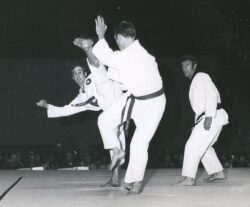
John & Pat Worley fighting with film star Chuck Norris judging
I have never been more excited! And, I think Pat was more excited for me, than he was for himself. He had defeated Jeff Smith the previous year, so he already had one US Championship title to his credit. In the championship match and with future film star Chuck Norris serving as center referee, Pat and I bowed and started our match. Since we had literally hundreds of sparring sessions together and since Pat was clearly the better fighter, it was a complete shock to everyone when I managed a one-point victory. But Pat and I both knew he would have won handily had I been anyone other than his big brother. I believe he wanted me to have a big victory more than he wanted it for himself. That’s the kind of brother that he is. Based on that win and a couple of other key wins, I joined the ranks of Pat, Jeff and a few other top Texas brown belts considered to be the best fighters in Texas.
During those early years, future film star Chuck Norris owned Karate schools in the Los Angeles area. He and fellow fighting champion Mike Stone promoted four annual LA area tournaments called the “Four Seasons.” Chuck Norris and Allen Steen were great friends having met and competed with each other a few years previously. GM Norris invited GM Steen to organize a Texas brown belt All Star team to come to LA and compete with a California team. GM Steen was happy to accept the challenge and invited my brother Pat, Jeff Smith, Harry Leggett, Rick Vaughn and Bill Watson to make the trip. I was invited as an alternate in the event any of our team was injured and couldn’t compete. We had three weeks to organize workouts to prepare for the competition and Jeff Smith would drive over 450 miles, one-way, to make the workouts—that’s how motivated he was to be included on the team.
The All-Star event was held in late May, 1969. An additional aspect of being selected to participate on the team included taking an exam, if eligible, for first degree black belt. Pat, Bill Watson, and I were eligible and requested permission to test. The exam was held in the Chuck Norris school located in the Redondo Beach area of LA. For such exams, the candidates prepare for weeks or months to demonstrate specific Martial Arts curriculum such as: forms, classical basics, and sparring—however, we had a very different experience. With a panel of Martial Arts icons, all of whom are legendary: Allen Steen, J. Pat Burleson, Chuck Norris, Mike Stone, Skipper Mullins and Joe Lewis; and with our teammates to provide support, we demonstrated whatever the panel members wanted to see. Because we had no idea what we would be required to do, we couldn’t afford to conserve energy and so we went as hard as we could on every aspect of the exam. Both Pat and Bill Watson were technically excellent martial artists; far superior to me and all I could do was try to impress the panel with my effort. They finally told us we were done; all except for sparring which would be demonstrated at the tournament the next day. I don’t think I’ve ever been as emotionally and physically exhausted as I was that Friday afternoon.
We went back to the hotel to recover and get ready for the tournament on Saturday. The event was packed with fans: Karate students of all ranks, as well as our friends, and families. There was a high level of excitement regarding the main event: Texas vs. California. We considered the LA team to be very competitive, but Texas Karate fighters were considered to be the toughest “blood and guts” fighters found anywhere in the US. The match turned out as expected: every round was hard-fought with passion and full out effort from every fighter on both teams. In the days prior to protective gear, the contact could be brutal: bloody noses, cuts and rib injuries were common. After five rounds, the Texas team finished with a fiercely contested one-point victory and afterward, both teams congratulated each other, and made plans to celebrate together after the event ended. That’s how martial artists are: they go from trying to physically destroy their opponent, to breaking bread with them a few hours later. There is great mutual respect that comes from a shared physical challenge.
Since none of our team members suffered any serious injuries and since I had not been needed in the team event, I asked GM Steen what I should do to satisfy the sparring requirement for the black belt exam. His solution was to line up my 5 teammates and have me spar each of them, one after the other. Since all of them were better fighters than me, it was not a fun experience. I managed to get through the bouts, pretty much all in one piece; and I think I earned some respect from my teammates.
At that time, GM Steen lined us up and announced our promotions: May 28, 1969 -First Degree Black Belt.
John Worley
10th Degree Grand Master
Cofounder National Karate Institute of Martial Arts
Special Announcement!
Grand Master Worley will be coming to Illinois to celebrate National Karate’s 50th Anniversary. Ask your instructor how you can be part of the “mass karate class” that he will conduct for our students!
To Read Part 2 of Grand Master Worely’s Story, Click Here
